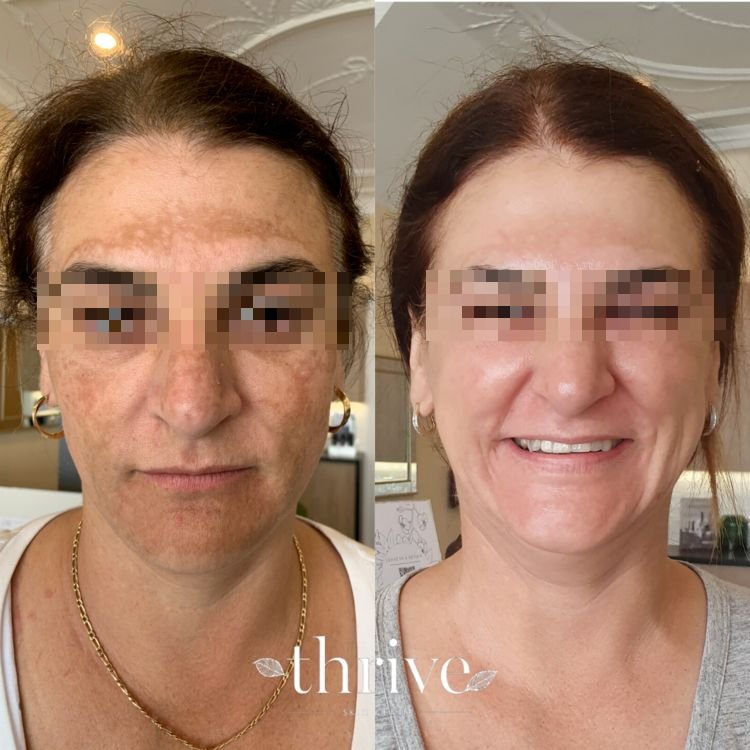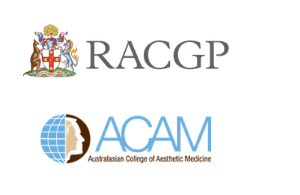Hyperpigmentation & Melasma- the root cause of pigmentation & how multi- modality treatments are the answer
/How & Why do we Produce Pigment?
Pigmentation gives our skin its colour and protects our skin from the sun.
Specialised cells in our skin called melanocytes make melanin (pigment) in response to UV light and heat. The melanocytes produce melanin like little umbrellas, to shield our skin cells from the subsequent cellular and DNA damage that UV light causes. Melanin does this by absorbing the UV light before it’s able to damage cell. So melanin is produced as a protective mechanism
Our genes determine what type of melanin and how much melanin we have in our skin and eyes. Darker skin types and brown eyes come from eumelanin. Lighter skin types produce pheomelanin, giving the skin a paler skin tone and blue/green eyes. Eumelanin is provides more photoprotection, as it absorbs more UV energy which is why darker skin types rarely become sunburnt.
When melanocytes overproduce pigmentation, this causes clumps of pigmentation to be produced in the skin, causing freckles, flat sun spots (lentignes) and “age warts” (raised pigmented lesion that look like stuck on brown ‘blue tack’ - seborrheic keratoses). These pigment types sit at different levels on the skin and can be treated with lasers and sometimes ablative methods
Some people also develop uneven, pigment patches on the skin, called hyperpigmentation. People with darker skin (e.g. Asian, Aboriginal, Indian or or Mediterranean skin) are much more likely to develop these patches. Sun exposure, age, hormones (pregnancy and the oral contraceptive pill) , inflammation from acne, eczema, autoimmune disease or trauma, and inappropriate heat from laser or peels are the most common trigger for this type of pigmentation. There is a strong genetic predisposition to hyperpigmentation, so if your mum or grandma has it, you are much more likely to develop it too.
Unfortunately, this type of hyperpigmentation can be difficult to treat as our usual weapons against skin (laser and peels) can actually make it WORSE. This leaves people with hyperpigmentation feeling frustrated and self-conscious because unfortunately, the most common site for hyperpigmentation is the face.
What is melasma and why do you get it?
Melasma is a subtype of pigmentation related to hormones. It commonly occurs on the forehead, cheeks, under the eyes, or above the lip and is often symmetrical. There are many myths about hormones and their role in melasma- after reading a lot of journal articles on this topic, the evidence is still unclear. What is clear is that changes in estrogen, progesterone and thyroid hormones may trigger melasma in genetically predetermined patients exposed to sun and heat .e.g starting the oral contraceptive pill and pregnancy are the most common triggers.
Its also important to note that heat exposure also drives pigmentation- for example I had a patient whose melasma improved after we reduced her regular “hot” yoga classes. Ongoing heat exposure like waxing can also drive melasma, so I advise threading as alternative approach if you are prone to upper lip hair and pigmentation.
There are a few (fascinating) reports about the role of low melatonin and Vitamin D deficiency in melasma, with case reports supporting supplements improving melasma. Emotional stress and oxidative stress is also implicated. So what’s clear here is that hormones are complex- they impact every cell in our body, and also have a complex system of interdependence where once hormone may impact many others, by either inhibition or activation, and sometimes both.
For many patients, melasma gets better when the trigger is removed, for example your pigmentation may get better after you have your baby and most people find their spots settle over winter. However, sometimes things don’t settle and this is when people usually present to me for assessment and to discuss management options.
How do we treat hyperpigmentation and melasma?
If you have bothersome pigmentation, the most important step is to arrange a consultation with a doctor experienced in skin disorders like a dermatologist or Cosmetic Physician. This is so we can diagnose the condition, which then allows to to treat it with a targeted approach.
New dark lesions need to be checked out with a dermatoscope to exclude signs of melanoma. A woods lamp examination helps us determine where the pigment is (superficial or deep) and also to determine specific characteristics of unusual pigmentation related to inflammatory disorders or autoimmune disease. In my practice, when I am seeing a patient with chronic melasma, I will often assess for secondary issues that are associated with pigmentation such as hormonal and nutritional imbalance. We may also need to review and discuss different contraceptive options.
After I have done these things we can then talk treatment.
How do we Treat Hyperpigmentation?
Treatment for Hyperpigmentation needs a discussion and review of options, depending on the cause of the pigment. There is no “one set” approach. Hence, the importance of consultation and diagnosis first.
No matter what the cause of your pigmentation issues, I always start with lifestyle advice : stay out of the sun and wear 50+ sun protection every day. This is non negotiable and if my patients are not doing this, I do not progress to lasers or active treatments as treatments wont work.
Besides SPF education, I prescribe a customised evidence-based home skin routine for each patient , focusing on active multi active serums to reduce pigment and brighten skin, as well as prime the skin for upcoming medical-grade treatments. Sometimes I will compound home care for pigmentation from a compounding chemist- occasionally, this approach alone works well.
Our dermal clinician sarah using IPL to pigmentation and redness from sun damage
For standard sun-induced sun spots in light skinned patients, I advise a series of at least 3 combination IPL (Intense Pulsed Light Therapy) and Q switch laser treatments. These light based treatments selectively target pigmentation, after which the pigment breaks up and slowly falls off the skin like coffee grounds. A test patch is compulsory before treatment- this is generally done the week before the planned treatment to ensure the best result.
Using multi modality approach to treating sundamage, pigmentation and redness give superior results. My protocols include using combination IPL, vascular laser and dual wavelength (532 and 1064nm) Q Switch Laser to target the many and varied pigment clumps you have in your skin and give you the best results.
This means we can also treat red spots, and pigmentation that is at the top and deeper in the skin. We also like to schedule a simple peel and exfoliation a few weeks after IPL to help lift off the pigmentation and refresh the skin, such as a Hydrafacial or a customised retinol, salicylilc or lactic acid peel. Laser and IPL treatments can cause complications like worsening pigment or burns- this is why it is important to use a good quality medical grade machine, have a test patch before treatment and see a technician who has had specific training.
For patients with darker skin types, melasma or inflammatory pigmentation we need a different approach, as IPL is too hot and aggressive and may make these skin types worse.
For these skin types we pull out our pigment using our Q switched Spectra laser , and use a combination 1064nm , 532nm or 660nm wavelengths. This gentle targets the deeper dermal pigment and breaks it up into tiny pieces through sound waves, not heat. It also stimulates collagen (great for ageing!) and has minimal downtime so it can be done at lunchtime.
We combine this type of laser with peels, often in the same sessions. Treatments are not as intense, and need to be done more often to see results. With the clinical protocols I have been using over the past few years, I generally see results in 3 monthly sessions. I also prescribe oral medication to reduce pigment activity and this combination approach yeilds good results with low associated risk.
660nm RuVY Touch Handpiece enables us to safely treat small freckles and pigment spots old darker skin
Cosmelan & Dermamelan Depigmentation Peels
The other option I always discuss with my patients is depigmentation peels. As the name suggests, these peels strip off pigment, but they also work to reduce the enzyme activity related to melanin production switching off melanin production.
Cosmelan & Dermamelan are a 2 step programme that involves an in-clinic peel which takes 30-40 minutes and is washed off after a prescribed time, depending on your skin type. The treatment continues with 3 months of home care and a package of LED treatments to use after the peel to calm down the expected skin irritation.
There are lots of positives about these treatments - they are effective for all types of pigmentation (we use Dermamelan for the deeper or :dermal” pigmentation), offer rapid depigmentation, and are safe and well-tolerated. The only times we can’t use either treatment is if you are pregnant or breastfeeding and we don’t advise it if you suffer from severe rosacea or acne. Results can be seen from the 2nd week, improving slowly over the next few months. It is common for skin to remain sensitive for a few months post peel. In terms of downtime- expect swelling and peeling, most of which settles by Day 5- 7. For these reasons, our clients usually prefer to do the treatment later in their week so the majority of the peeling is done on the weekend.
Depigmentation peels reduce pigmentation no matter what the cause is, and although they can give amazing results, they don’t cure the underlying cause. This is why it’s good to see a clinic that understands the underlying cause of your pigmentation and can help you with a long term plan to keep your amazing results in check.
That said, depigmentation peels can give life changing results and many of my patients return every few years for a maintenance treatment.
THE Cosmelan peel stays on for 8- 12 hours
cosmelan peel works for post inflammatory pigmentation in Mediterranean skin
Cosmelan Peel works for Asian and darker skin types
Expectation Management
Despite the treatments above, we always try to educate our clients that many pigment disorders are chronic meaning that there is no cure, and the pigment will return- you should not expect any treatment to give you life long clearance because we are dealing with genes, hormones and we live in Australia which has high levels of UV light. We are also often dealing with healthy people who love the outdoor coastal life- We want you do live your life and encourage letting go of wanting perfect skin and focusing on healthy skin! Daily sun avoidance and 50+ SPF protection (even in winter), and long term use of a tyrosinase inhibitor can help to reduce the risk of pigment returning.
We’d love to see you in the clinic and help to improve your pigment concerns. We have so much to offer at Thrive, with medical input, clinicians, experienced dermal clinicians and evidence based devices and treatments. We have all done IPL, QSl or Cosmelan ourselves and love to support out patients through the journey towards healthier skin.












